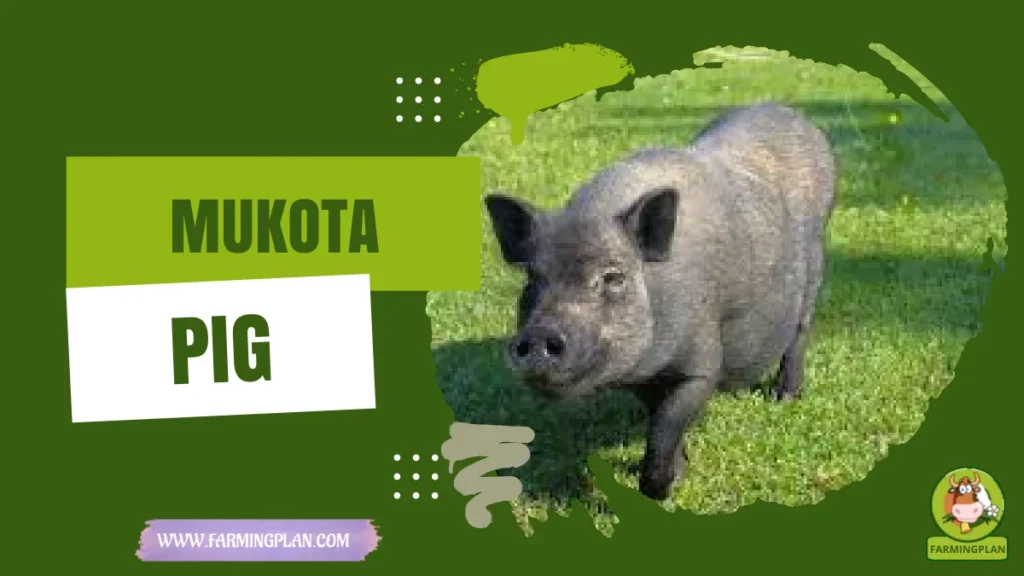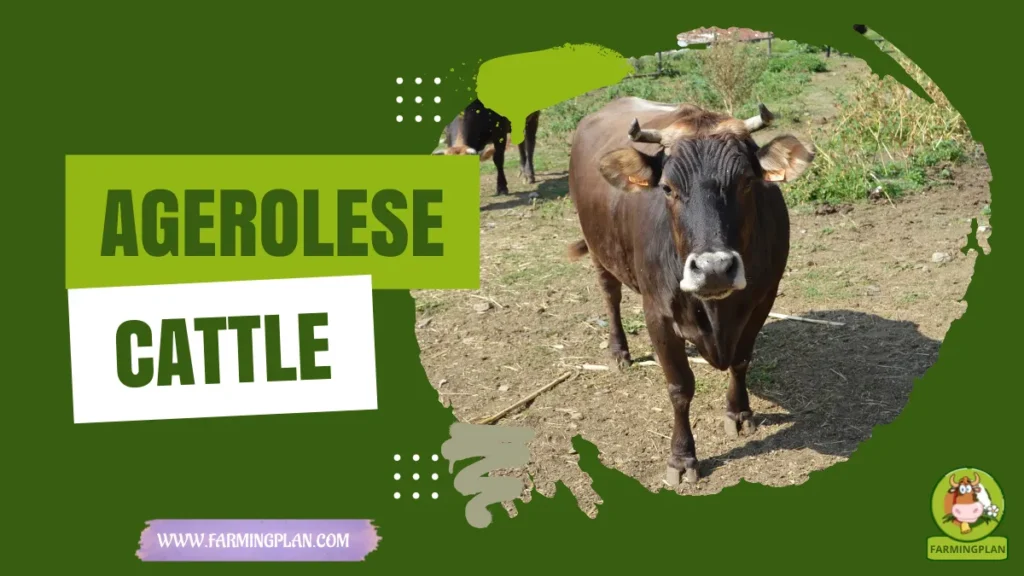If you’re thinking about raising Southdown Sheep, you’re in for a treat. These little charmers, often called “babydoll Southdowns,” have stolen the hearts of pet lovers, breeders, and farmers alike. Whether you’re looking for a compact, wooly companion or a productive member of your flock, Southdown Sheep fit the bill. They’re friendly, hardy, and just the right size for hobby farms or family-friendly setups. In this guide, I’ll walk you through everything you need to know—feeding, caring, breeding, and beyond. As someone who’s spent years in animal husbandry, I can tell you: Southdowns are a joy to work with and a smart pick for both show rings and backyard farms.
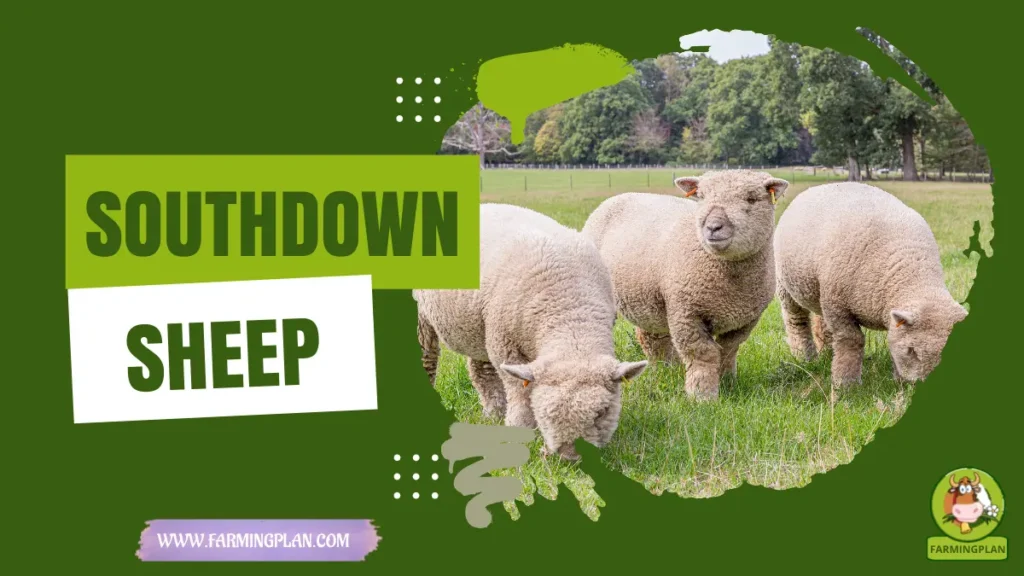
History & Origin of Southdown Sheep
Southdown Sheep are an ancient British breed with roots going all the way back to the English South Downs of Sussex. These little guys are part of the oldest purebred sheep breeds in the world. In the 18th century, farmers began selectively breeding them for meat and wool. Their dense fleece and compact size made them ideal for the wet, chilly climates of southern England.
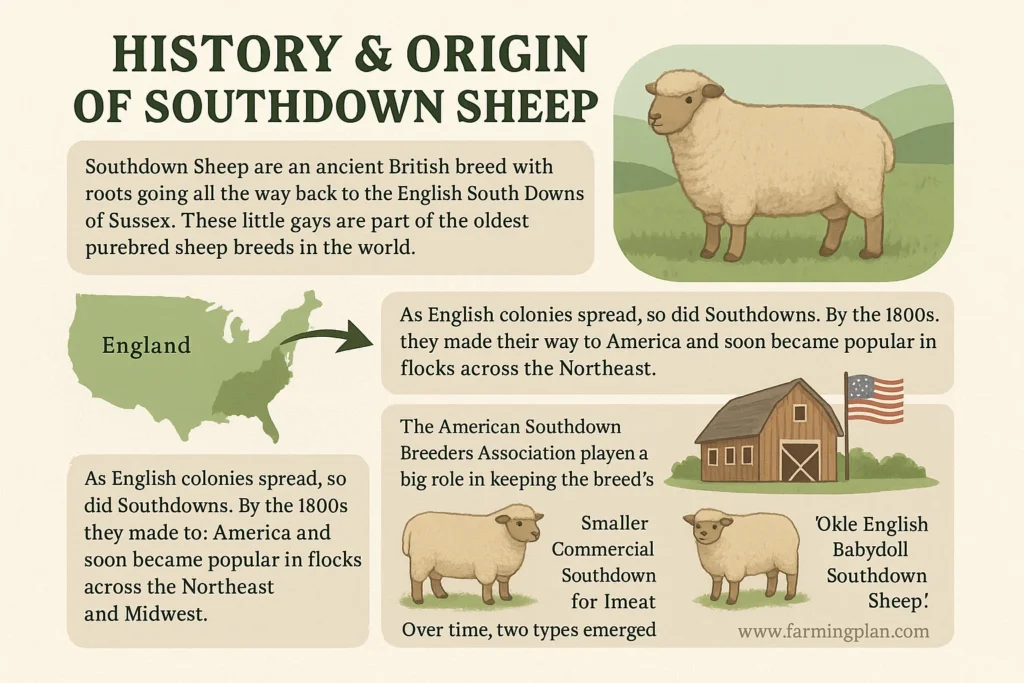
As English colonies spread, so did Southdowns. By the 1800s, they made their way to America and soon became popular in flocks across the Northeast and Midwest. The American Southdown Breeders Association played a big role in keeping the breed’s standards intact. Over time, two types emerged: the larger, commercial Southdowns bred for meat, and the smaller “Olde English Babydoll Southdown Sheep,” bred to preserve the original look and size.
Read More: Arabi Sheep: How To Start Your Farm
Characteristics of Southdown Sheep
Southdown Sheep are a unique breed, easily recognizable by their short, stout stature and thick, curly fleece. Mature ewes weigh between 130-180 lbs (59-81 kg), while rams can reach 190-230 lbs (86-104 kg). Their wool, falling in the 23.5–29.0 micron range, is fine enough for hand spinning yet durable for wear, making them a fascinating breed to work with.
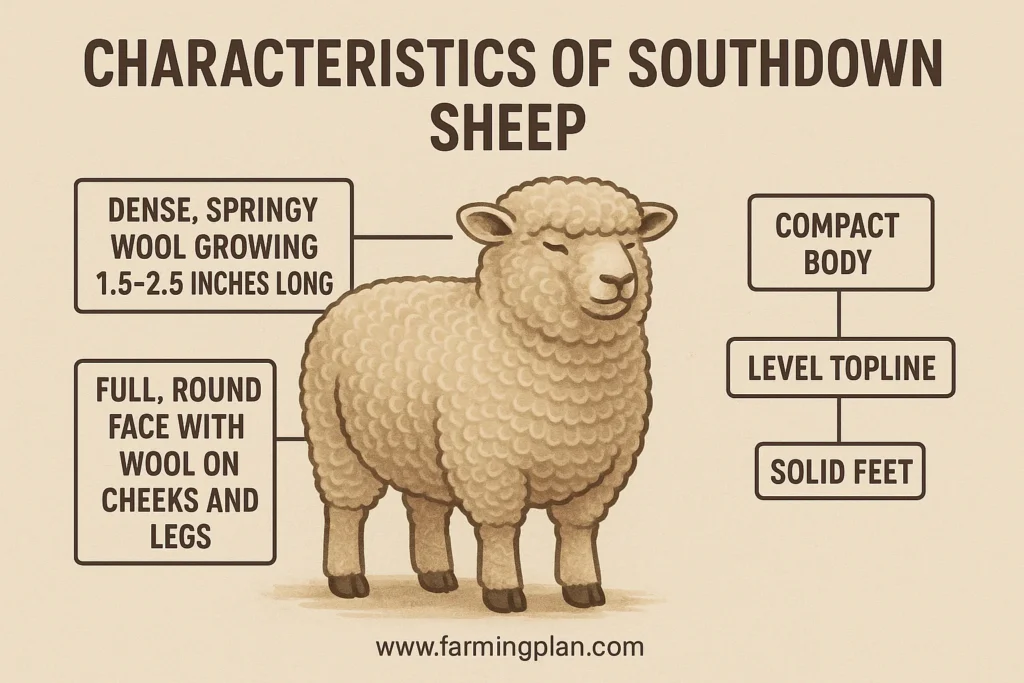
Their wool is dense and springy, growing to 1.5-2.5 inches long. You’ll also notice they have full, round faces with wool right up to their cheeks and legs. This gives them a “babydoll” look that melts hearts. If you’re aiming for show quality, conformation matters—original breed standards emphasize compact bodies, level toplines, and solid feet.
Read More: Afghan Arabi Sheep: Strong, Hardy & Valuable
Nature & Temperament of Southdown Sheep
One of the most endearing qualities of Southdowns is their calm and affectionate temperament. They are easy to handle, making them a great choice for beginners or families. Many people even raise babydoll Southdowns as companion animals, a testament to their gentle nature and ease of handling.
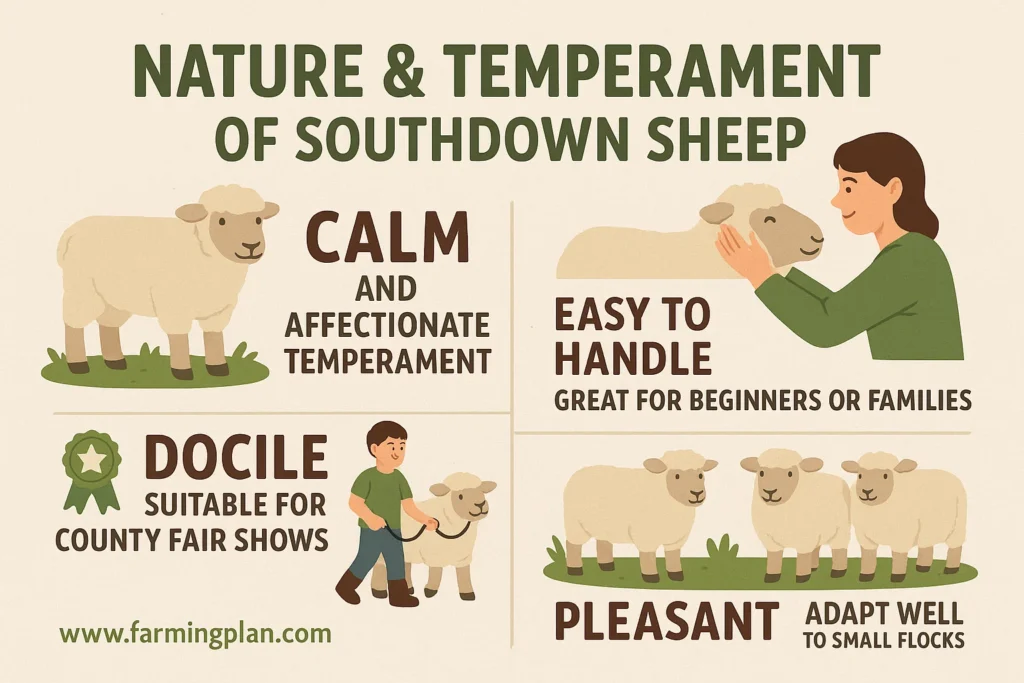
Southdown Sheep naturally docile and adapt well to small flocks. Kids can show them at county fairs without any trouble. And if you’re breeding show animals or building a commercial flock, their gentle nature makes daily chores less stressful. They aren’t jumpy or high-strung like some larger breeds, and I find them downright pleasant to be around.
Read More: Jacob Sheep: Discover the Unique Benefits of Raising
Food & Diet
Feeding Southdown Sheep isn’t too complicated, but balance is key. I keep mine on high-quality pasture during the warmer months and supplement with hay when grass runs low. Each adult sheep eats about 2-3% of their body weight in forage daily.
Southdown Sheep also need minerals—especially selenium in deficient regions—and constant access to fresh water. I avoid too many grains unless they’re nursing or underweight, as it can upset their rumen. A good mineral block and the occasional apple or carrot make happy, healthy sheep. And of course, no moldy hay—ever.
Usage & Purpose
Southdown Sheep are a dual-purpose breed. Historically, they’ve been used for both meat and wool. The meat is tender and flavorful, with fine-grained cuts that chefs love. Their smaller size means you won’t get massive chops like with larger meat breeds, but the quality is top-notch. Wool lovers adore their curly fleece for hand spinning and felting projects. It’s got the perfect blend of softness and bounce. And of course, babydoll Southdowns are popular in petting zoos, homesteads, and as pasture pets thanks to their charming looks and easygoing nature.
Special Features
What truly sets Southdowns apart is their adaptability. They thrive in wet climates, thanks to their dense wool, and their short stature helps reduce parasite load. This adaptability makes them a secure and confident choice for sheep farmers, regardless of the climate or conditions. Their fleece has barbs per inch that make it ideal for felting—something I learned the fun way after a rainy shearing day turned into a DIY scarf session. These sheep are also known for staying productive into older age, unlike some breeds that peak early and fade fast. Bonus: they rarely need dehorning or docking!
Health Issues & Prevention
Southdowns are generally hardy, but like all sheep, they can run into a few health snags. Foot rot, internal parasites, and flystrike are common issues if you don’t stay ahead with prevention. I trim hooves regularly, rotate pastures, and keep bedding dry to prevent foot problems. Deworming should be done based on fecal counts—don’t just blanket treat unless you’ve got signs of a problem. Watch for coughing, weight loss, or rough coats. And remember: vaccinations like CDT are your best friend. A healthy flock starts with consistent care and a watchful eye.
Step-by-Step Farming Guide
Raising Southdown Sheep can feel overwhelming at first, but with a clear plan, it becomes a rewarding experience. In this step-by-step farming guide, I’ll walk you through everything you need to know—from setting up your pasture to daily care—so you can build a healthy, happy flock with confidence. Let’s dive in and make sheep farming simple and enjoyable!
Step 1: Set Up a Safe Shelter
Southdowns don’t need fancy barns, but they do need a dry, draft-free space. I use a three-sided shed with plenty of straw bedding. Ventilation is key—stale air causes respiratory issues, especially in winter. Keep gates secure and fencing low. These sheep aren’t jumpers, but predators sure are. I always recommend a guardian animal like a llama or livestock dog, especially in rural areas.
Step 2: Build the Right Diet
Start with good pasture. If you’ve got access to clover, alfalfa, or mixed grasses, that’s perfect. Supplement with hay in winter and add grain only for nursing ewes or growing lambs. Provide mineral supplements and fresh water daily. I use loose minerals in a covered feeder to prevent moisture clumps. And never feed moldy hay—it can cause listeriosis.
Step 3: Routine Health Checks
Make hoof trimming a regular habit—every 6-8 weeks works for most. Check eyes, teeth, and overall condition monthly. I deworm based on need, not schedule, and rotate dewormers to prevent resistance. Keep records. Track weight, breeding cycles, and any health concerns. A small logbook or app goes a long way in managing your flock like a pro.
Step 4: Breeding and Lambing Time
I usually breed in the fall for spring lambs. Southdowns have an average gestation of 145 days. I separate my ewes into lambing pens about two weeks before their due date. Lambs are small, vigorous, and usually nurse right away. Keep colostrum on hand just in case, and dip navels in iodine. Within a week, they’re bouncing around like tiny sheep rockets.
Great Sheep Farming Starts With Simple Steps And A Lot Of Heart—Your Southdown Flock Will Thank You!
Expert Tips & Best Practices
One of the best ways to keep your Southdown Sheep healthy is to trim their hooves before winter sets in. Mud and snow can easily cause infections if their feet aren’t properly cared for. Regular trimming keeps them comfortable and prevents nasty foot problems down the road.
Protecting your flock from predators is crucial, especially if you’re farming in rural areas. I recommend using electric fencing or sturdy mesh panels to create a safe barrier. These fences give you peace of mind and help keep your sheep secure day and night. Shearing your Southdowns in early spring does more than just harvest their lovely fleece. It also helps them avoid overheating during warmer months and reduces the risk of flystrike, a common and painful issue for sheep with dense wool.
When it comes to growing your flock, always choose lambs from reputable breeders like Doak Southdowns or Scramlin Southdowns. These breeders maintain high standards and healthy stock, making your farming journey smoother and more enjoyable. If you’re new to raising Southdowns, starting small is the way to go. Having just two or three ewes and one wether lets you learn the ropes without feeling overwhelmed. It’s easier to manage and gives you a chance to build confidence before expanding.
Pasture rotation is a game changer for parasite control. Moving your sheep between different grazing areas regularly helps break the parasite lifecycle and keeps your flock healthier naturally. Lastly, always keep a well-stocked medical kit on hand. Essentials like antiseptic spray, gloves, syringes, and electrolytes can make all the difference when dealing with minor injuries or illnesses quickly and effectively.
FAQ
Are Southdown Sheep good for beginners?
Absolutely. Their small size and calm nature make them perfect for new farmers or families with kids.
How much wool do Southdowns produce?
They typically yield 5–8 pounds of fleece per year, with fiber around 23–29 microns—great for hand spinning.
Are babydoll Southdowns the same as regular Southdowns?
Babydolls are smaller and bred to resemble the original Southdowns. They’re also popular as pets and show animals.
Where can I buy babydoll Southdown lambs?
Check breeders through the Olde English Southdown Registry or local farm networks. Look for healthy, registered stock.
Can I raise Southdowns with other animals?
Yes, they get along well with goats, chickens, and even friendly dogs—just make sure everyone has space.
Conclusion
Raising Southdown Sheep is a rewarding experience whether you’re in it for wool, meat, show, or just a peaceful pasture companion. These gentle, hardy animals bring a lot of value to small farms and family homesteads. With the right setup, proper diet, and regular care, Southdowns will thrive—and so will you. I’ve spent years with these sheep, and they never fail to bring joy (and the occasional laugh) to life on the farm.

